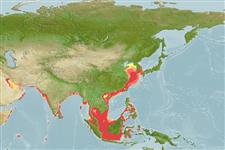Common names from other countries
Environment: milieu / climate zone / depth range / distribution range
Ecologie
Pelagisch; anadroom (Ref. 75906); diepteverspreiding 0 - 250 m (Ref. 356). Tropical; 90°N - 7°S, 46°E - 130°E
Indo-West Pacific and Asia Inland Waters: Neophocaena phocaenoides phocaenoides: Persian Gulf, South China Sea, East China Sea, Indonesia, Philippines, Turtle Islands, Sulu Sea; Neophocaena phocaenoides sunameri: China, Korea, Japan, East China Sea; Neophocaena phocaenoides asiaeorientalis: Yangtze River, China (Ref. 1522). Found in tropical to warm temperate coastal waters (Ref. 81021).
Length at first maturity / Size / Gewicht / Leeftijd
Maturity: Lm 140.0, range 135 - 145 cm Max length : 227 cm TL mannelijk/geslacht niet bekend; (Ref. 81030)
Found in both fresh and marine. Feeds on small fishes, squids and shrimps; also ingests some plant material including leaves and rice (Ref. 1394). In 2006, a population survey was able to record a total of 300 individuals of Neophocaena phocaenoides asiaeorientalis, as experts provide an estimate of 1,400 individuals based on the said survey. This is considered a 50% decline from the survey done in 1991 (Ref. 85336). Found in tropical to warm temperate coastal waters, i.e., shallow bays, mangrove swamps, estuaries and large rivers, but mainly prefers estuarine waters (Ref. 81021). Occurs singly, in pairs, or in small groups of up to 12 individuals. Not as showy as other dolphins; though, they are occasionally seen breaking the surface in calm seas (Ref. 801). Feeds on small fishes, squids and shrimps; also ingests some plant materials including leaves and rice (Ref. 1394).
Tan, J.M.L. 1995. (Ref. 936)
Status op de Rode Lijst van het IUCN (Ref. 130435)
Status bij CITES (Ref. 108899)
Gebruik door de mens
Visserij: commercieel
FAO - Visserij: landings, soortsprofiel | FishSource | Sea Around Us
Tools
Internet-bronnen
Estimates based on models
Preferred temperature
(Ref.
115969): 24.4 - 29.2, mean 28.3 (based on 1892 cells).
Weerstandsvermogen
Hoog, minimale populatieverdubbelingstijd minder dan 15 maanden (K=0.71-0.74; tm=5).
Kwetsbaarheid
Moderate vulnerability (41 of 100).
Prijsklasse
Unknown.
